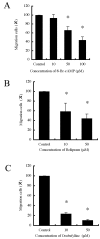Phosphodiesterase 4 regulates the migration of B16-F10 melanoma cells
- PMID: 22970026
- PMCID: PMC3439151
- DOI: 10.3892/etm.2012.587
Phosphodiesterase 4 regulates the migration of B16-F10 melanoma cells
Abstract
Phosphodiesterases (PDEs) are important regulators of signal transduction processes. Eleven PDE gene families (PDE1-11) have been identified and several PDE isoforms are selectively expressed in various cell types. PDE4 family members specifically hydrolyze cyclic AMP (cAMP). Four genes (PDE4A-D) are known to encode PDE4 enzymes, with additional diversity generated by the use of alternative mRNA splicing and the use of different promoters. While PDE4 selective inhibitors show therapeutic potential for treating major diseases such as asthma and chronic obstructive pulmonary disease, little is known concerning the role of PDE4 in malignant melanoma. In this study, we examined the role of PDE4 in mouse B16-F10 melanoma cells. In these cells, PDE4 activity was found to be ∼60% of total PDE activity. RT-PCR detected only PDE4B and PDE4D mRNA. Cell growth was inhibited by the cAMP analog, 8-bromo-cAMP, but not by the specific PDE4 inhibitors, rolipram and denbufylline, which increased intracellular cAMP concentrations. Finally, migration of the B16-F10 cells was inhibited by the PDE4 inhibitors and 8-bromo-cAMP, while migration was increased by a protein kinase A (PKA) inhibitor, PKI(14-22), and was not affected by 8-pCPT-2'-O-Me-cAMP, which is an analog of exchange protein activated by cAMP (Epac). The inhibitory effect of rolipram on migration was reversed by PKI(14-22). Based on these results, PDE4 appears to play an important role in the migration of B16-F10 cells, and therefore may be a novel target for the treatment of malignant melanoma.
Figures





Similar articles
-
Challenge of human Jurkat T-cells with the adenylate cyclase activator forskolin elicits major changes in cAMP phosphodiesterase (PDE) expression by up-regulating PDE3 and inducing PDE4D1 and PDE4D2 splice variants as well as down-regulating a novel PDE4A splice variant.Biochem J. 1997 Jan 1;321 ( Pt 1)(Pt 1):165-75. doi: 10.1042/bj3210165. Biochem J. 1997. PMID: 9003416 Free PMC article.
-
A role for cyclic nucleotide phosphodiesterase 4 in regulation of the growth of human malignant melanoma cells.Oncol Rep. 2007 May;17(5):1133-9. Oncol Rep. 2007. PMID: 17390056
-
Dexamethasone down-regulates cAMP-phosphodiesterase in human osteosarcoma cells.Biochem Pharmacol. 2005 Jan 15;69(2):267-75. doi: 10.1016/j.bcp.2004.09.012. Epub 2004 Nov 6. Biochem Pharmacol. 2005. PMID: 15627479
-
Cyclic AMP-specific phosphodiesterase-4 as a target for the development of antidepressant drugs.Curr Pharm Des. 2009;15(14):1688-98. doi: 10.2174/138161209788168092. Curr Pharm Des. 2009. PMID: 19442182 Review.
-
Proposal for pharmacologically distinct conformers of PDE4 cyclic AMP phosphodiesterases.Cell Signal. 1997 May-Jun;9(3-4):227-36. doi: 10.1016/s0898-6568(96)00173-8. Cell Signal. 1997. PMID: 9218122 Review.
Cited by
-
Development of a Macrophage-Related Risk Model for Metastatic Melanoma.Int J Mol Sci. 2023 Sep 6;24(18):13752. doi: 10.3390/ijms241813752. Int J Mol Sci. 2023. PMID: 37762054 Free PMC article.
-
67-kDa laminin receptor-dependent protein phosphatase 2A (PP2A) activation elicits melanoma-specific antitumor activity overcoming drug resistance.J Biol Chem. 2014 Nov 21;289(47):32671-81. doi: 10.1074/jbc.M114.604983. Epub 2014 Oct 7. J Biol Chem. 2014. PMID: 25294877 Free PMC article.
-
Transcriptional co-activator regulates melanocyte differentiation and oncogenesis by integrating cAMP and MAPK/ERK pathways.Cell Rep. 2021 May 18;35(7):109136. doi: 10.1016/j.celrep.2021.109136. Cell Rep. 2021. PMID: 34010639 Free PMC article.
-
Activation of β2-adrenergic receptor by (R,R')-4'-methoxy-1-naphthylfenoterol inhibits proliferation and motility of melanoma cells.Cell Signal. 2015 May;27(5):997-1007. doi: 10.1016/j.cellsig.2015.02.012. Epub 2015 Feb 20. Cell Signal. 2015. PMID: 25703025 Free PMC article.
-
The Role of Cyclic Adenosine Monophosphate (cAMP) in Modulating Glucocorticoid Receptor Signaling and Its Implications on Glucocorticoid-Related Collagen Loss.Int J Mol Sci. 2023 Jun 15;24(12):10180. doi: 10.3390/ijms241210180. Int J Mol Sci. 2023. PMID: 37373328 Free PMC article.
References
-
- Thompson JF, Scolyer RA, Kefford RF. Cutaneous melanoma. Lancet. 2005;36:687–701. - PubMed
-
- Eggermont AM, Robert C. New drugs in melanoma: it’s a whole new world. Eur J Cancer. 2011;47:2150–2157. - PubMed
-
- Beavo JA, Houslay MD, Francis SH. Cyclic nucleotide phosphodiesterase superfamily. In: Beavo JA, Francis SH, Hously MD, editors. Cyclic Nucleotide Phosphodiesterases In Health and Disease. CRC Press; New York: 2007. pp. 3–17.
-
- Hously MD, Schafer P, Zhang KY. Keynote review: phosphodiesterase-4 as a therapeutic target. Drug Discov Today. 2005;10:1503–1519. - PubMed
-
- Hously MD. Underpinning compartmentalized cAMP signaling through targeted cAMP breakdown. Trends Biochem Sci. 2010;35:91–100. - PubMed
LinkOut - more resources
Full Text Sources
Other Literature Sources
Miscellaneous
